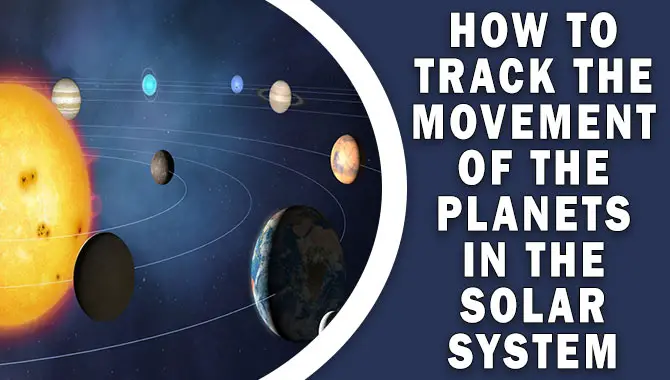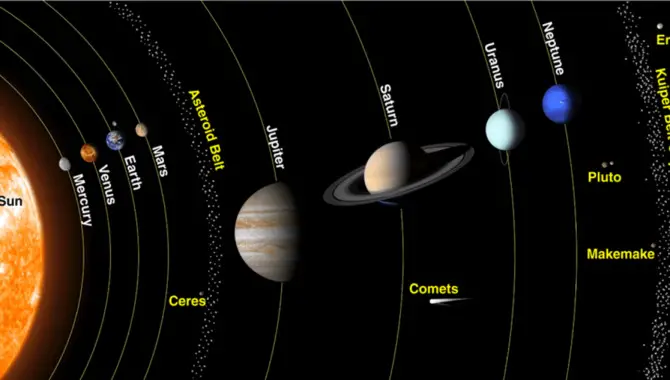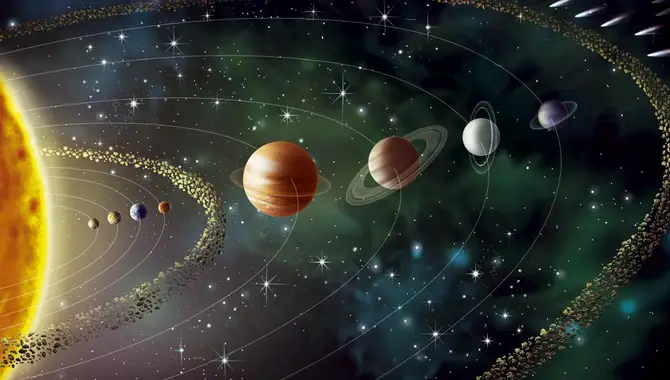There are many ways to track the movement of planets in the Solar System. One way is to use a planetarium program like Stellarium. Another way is to use a telescope and look for the planets yourself.

Contents
How Can I Tell Where Each Planet Is In The Solar System?

In this article, we’ll show you how to find each planet in the solar system and give you a real-life example of each one. The first planet in our solar system is Mercury. It is the closest planet to the sun and can be seen in the early morning or late evening sky. To find Mercury, look for a bright object in the sky close to the horizon.
The second planet is Venus. It is the brightest object in the sky after the sun and can be seen in the early morning or late evening. To find Venus, look for a bright object in the sky close to the horizon.
The third planet is Earth. It is the only planet in our solar system that is invisible to the naked eye. The fourth planet is Mars. It can be seen in the night sky as a reddish object. To find Mars, look for a bright object in the sky close to the horizon.
The fifth planet is Jupiter. It is the largest planet in our solar system and can be seen in the night sky as a bright object. To find Jupiter, look for a bright object in the sky close to the horizon.
- The sixth planet is Saturn. It can be seen in the night sky as a bright object. To find Saturn, look for a bright object in the sky close to the horizon.
- The seventh planet is Uranus. It can be seen in the night sky as a blue-green object. To find Uranus, look for a bright object in the sky close to the horizon.
- The eighth planet is Neptune. It can be seen in the night sky as a blue object. To find Neptune, look for a bright object in the sky close to the horizon.
Which Planets Are Currently Visible?

This is a question that many people ask. The planets that are currently visible depend on a few factors. The time of day, the time of year, and where you are on Earth, all play a role in which planets you can see.
Let’s start with the time of day. If it is daytime, you cannot see any planets. This is because the sun is out and too bright to see anything else in the sky. At night, you are more likely to be able to see planets. This is because the sun is not out, and the sky is darker.
The time of year also plays a role in which planets are visible. In the summer, you are more likely to see Jupiter and Saturn. This is because they are closer to the sun and stay in the sky longer. In the winter, you are more likely to see Mars and Venus. This is because they are far from the sun and not up in the sky for as long.
Finally, where you are on Earth also affects which planets you can see. In the Northern Hemisphere, you are more likely to see Jupiter and Saturn. You are more likely to see Mars and Venus in the Southern Hemisphere. This is because of the tilt of the Earth.
How Fast Are The Planets Moving?

Most people are aware that the planets orbit the sun, but
Did you know that they orbit at different speeds?
The speed at which its distance from the sun determines a planet’s orbits. The planets closer to the sun, like Mercury and Venus, orbit much faster than those farther from the sun, like Jupiter and Saturn.
To give you a better understanding, let’s compare the speeds of some of the planets. Mercury, the closest planet to the sun, orbits at a speed of about 47 km/s. Venus is a little bit slower, orbiting at about 35 km/s. In the middle of the two, Earth orbits at a speed of about 29 km/s. As we move out to the gas giants, the speeds decrease. Jupiter, the largest planet, orbits at a speed of about 13 km/s, and Saturn, the second largest, orbits at about nine km/s.
Now that you know a little bit more about the speeds of the planets, you might be wondering how fast they’re moving about us. The short answer is that they’re all moving pretty fast. For example, Mercury, the closest planet to the sun, is currently orbiting at a speed of about 47 km/s.
That means it’s orbiting the sun at about 47,000 km every hour! And Venus, which is a little bit slower, is currently orbiting at about 35 km/s. That means it’s orbiting the sun at about 35,000 km every hour.
So the next time you’re looking up at the night sky, take a minute to think about how fast the planets are moving!
When Will The Planets Line Up Again?
We all love a good planetary alignment when all the planets in our solar system line up perfectly. But when will the planets line up again?
The last time the planets lined up was in 1982, a spectacular event. All the planets were perfectly aligned, with the sun in the middle. It was an amazing sight to behold.
The next time the planets will line up is in the year 2040. That’s not too far away! So make sure you mark your calendars and check it out. It’s going to be an event you won’t want to miss.
What Causes The Planets To Move?
The answer has to do with gravity. Gravity is how a planet or other body draws objects toward its center. The force of gravity keeps all planets in orbit around the sun. Earth’s gravity keeps you on the ground and makes things fall.
The mass of an object causes gravity. The more mass an object has, the more gravity it has. So, the heavier an object is, the stronger its gravity is. The force of gravity also gets weaker with distance. So, the closer objects are to each other, the stronger their gravitational pull is.
Earth’s gravity comes from all its mass. All its mass makes a combined gravitational pull on all the mass in your body. That’s what gives you weight. And if you were on a planet with less mass than Earth, you would weigh less than you do here.
The planets orbit the sun because of the sun’s gravity. The sun is so huge and has so much mass that its gravity pulls the planets toward it. But the planets are also moving fast. So fast that they keep flying out into space instead of falling into the sun.
All planets have gravity. But the bigger the planet, the stronger its gravity is. So, Jupiter has more gravity than Earth. And Saturn has more gravity than Jupiter. The planets’ gravity keeps them in orbit around the sun. It also makes it possible for you to stand on Earth and walk around. And it’s what makes things fall to the ground.
Hopefully, you are clear on how to track the movement of the planets in the Solar System. If you still have any questions, feel free to comment below.
